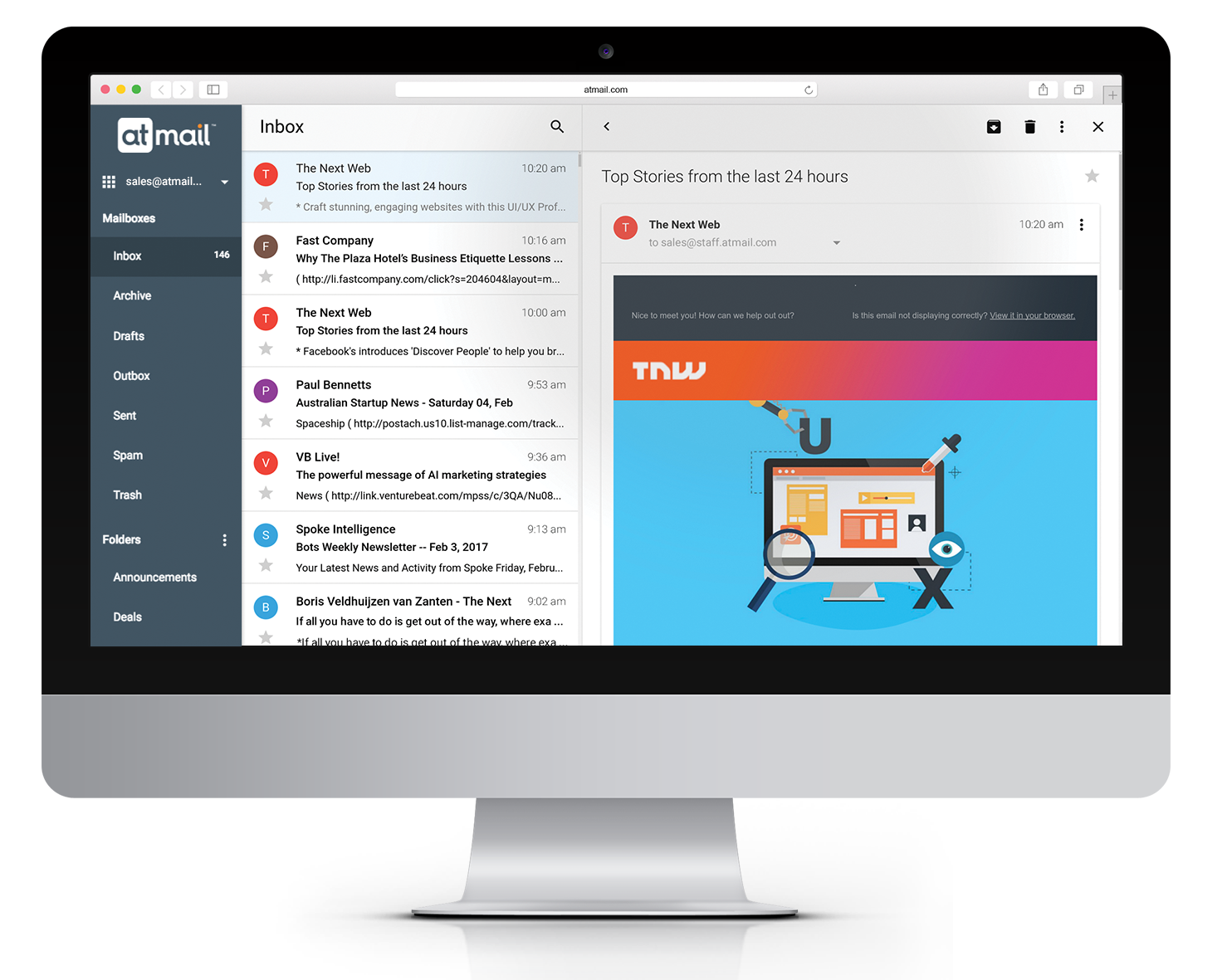
3 Reasons to Upgrade & Why Your Customers Will Love You for It!
If you are a CIO or CTO with the responsibility of selecting and/or maintaining your company’s email platform (and keeping your end users happy), you’ll know how critical it is that you are running the most reliable, best-fit email solution for your size, needs and budget.
From our 20 years of email experience, we’ve too often seen that failing to choose the correct email solution usually results in one of the biggest daily headaches you’ll ever have as a C-suite executive. System administrators will complain (because they can’t run a reliable, pain-free email system if they’ve been given the wrong system to run) and end users will complain (because despite much-hyped alternatives such as Slack, email still rules supreme and your end users depend on email for essential interaction with the world).
If you are a current atmail 7 customer (or a potential atmail customer) who is reassessing whether your current email solution matches where your organisation wants to be both now and in the future, here are three reasons to upgrade to atmail suite and atmail mail server – and why your customers will love you for it!
1 . Our webmail is completely rearchitected for a superfast, scalable and awesome user experience
The Virtual DOM
atmail suite comprises our new webmail UI (version 8), JMAP Proxy and native app. Our webmail UI is built on React (based on JavaScript) – the same cutting edge, UI technology created by, championed and extensively tested by Facebook. One of the beauties of React is that it uses componetised development, which promotes code reusability, reduces coupling, increases cohesion and is tuned for performance.
React’s virtual DOM makes atmail suite faster than traditional email systems. The virtual DOM keeps track of what changes need to be made in the actual DOM and then pushes these out faster and more efficiently. This means that it basically re-renders the entire component each time there is a data change. Basically, on every update:
- React builds a new virtual DOM subtree;
- It then compares this with the old one;
- Next, it computes the minimal set of DOM mutations and puts them in a queue; and
- Finally, it batch executes all updates.
Since its release as open source in 2013, React has been embraced by heavyweights such as Netflix, Instagram, The New York Times, WhatsApp, Yahoo! Mail, Dropbox and Atlassian. In short, your customers are already interacting with interfaces powered by React, so the atmail suite experience is intuitive for them. Additionally, with such big names backing the library, you can be confident in its ongoing compatibility with all modern devices and browsers.
If you’re a video game player, you’ll relate to our Doom 3 engine explanation here.
Live event updating and real-time synchronisation with JMAP Proxy
atmail suite’s JMAP Proxy is written in Go(lang) – a server-focussed programming language created by, used and extensively tested by Google.
Go has a highly performant, compiled, native binary, with strong typecasting and a small resource footprint. In layman terms, this means that Go can increase speeds and decrease costs – which is music to the ears of any CIO or CTO looking to employ modern technology, but at the same time, reduce IT costs.
atmail suite greatly benefits from JMAP – a new standard for email clients to connect to existing mail stores.
JMAP provides aggregated data from many different services and protocols and presents it in a consistent and clearly defined API. All mail, contact, calendar and tasks data is represented as JSON, which provides a much lower network overhead, while live-alerting keeps all mail, contact, calendar and tasks in synchronisation across all devices in realtime.
As my colleague Jason Brown explains here, “JSON Meta Application Protocol (JMAP) helps make email better because it provides a way to make communication with email back ends consistent when using multiple devices. JMAP makes it possible for me to get my email on all of these devices updated nearly simultaneously.
How does it do this?
JMAP sits between the atmail user interfaces (both web and mobile devices) and the atmail server components (IMAP, DAV and admin) and decides when to push data from my mobile to the IMAP server on the back end, or when to tell the web client that there is an update on the server that needs to be viewed.
Why do we need JMAP for this? Doesn’t IMAP already handle this?
Well, yes and no. Technically IMAP does do these things, but it doesn’t do them as efficiently as it does with JMAP, with people using more than two devices at a time for email. Ask any service provider and they will tell you that whilst traffic rates are not growing as quickly anymore, the number of simultaneous connections is growing rapidly – soon, IMAP just won’t cut it.”
This means that our JMAP Proxy helps you better scale your business, because it helps us to better scale our mail client as you scale.
So, if your organisation plans to scale your user base in the near future, tapping into the power of our JMAP Proxy is another smart reason to upgrade your atmail email platform.
Modern, device-responsive UI
Our most attractive and intuitive design yet, atmail suite continues to improve the user experience with its minimalistic, friendly user interface (UI) and ease of use, which has been even further improved with our most recent release, atmail suite 8.3.0 (including Tasks). Customers who appreciate speed and usability will love you for upgrading to atmail suite.
2. One webmail licence covers everything
As an atmail 7 customer, you would be familiar with the choice of a “Basic” or “Pro” plan. However, with our latest webmail product, atmail suite, there is no more “Basic” or “Pro” – one webmail licence gets you ‘everything webmail’. atmail suite is licensed per mailbox and comes with email, contacts, calendars and tasks (with storage to be released very soon).
Note: As always, system administrators can decide which features to make available to customers and, with class of service support and advertising on our roadmap, your monetisation options will soon include in-app feature purchase and multiple advertising options.
3. Automation is easy with our mail server
atmail’s mail server redefines the delivery of atmail’s core services – providing a highly modular and scalable solution for mass-installations, which leverages an automation engine to increase the ease and simplicity of the deployment and configuration of IMAP, SMTP, AV, AS and ManageSieve servers on demand.
atmail’s new mail server (which is deliberately modular and an optional extension if you’re looking for an on-premises back end that pairs perfectly with atmail suite) includes a fully customisable Role-based access control (RBAC) model for permissions, allowing you to configure and customise as many different admin roles as you need to empower your entire IT team – from your service desk warriors in the trenches on the front-line, to your behind the scenes, system administration team.
Still powered by atmail’s open and documented admin API, you can continue to integrate with your existing business systems to provision, manage and deprovision your customer’s accounts automatically and on demand.
Paired with the atmail suite’s webmail UI and JMAP Proxy, the full stack allows for incredibly easy domain management (users, settings, groups, domains and aliases).
Need more reasons to upgrade to atmail suite and mail server?
If you’d like to upgrade to atmail suite and/or atmail mail server but need more information before making the switch, we invite you to take a look here for our full list of atmail suite’s main highlights, features, advantages and benefits. And as always, we welcome any questions here.
What if I don’t upgrade?
As demonstrated by Apple’s recent Batterygate scandal, all technology users run the risk of being left at the altar if they don’t upgrade their solutions in a timely manner. Technology simply advances so fast that even the very best solution three years ago might not be the very best solution today.
Whether you upgrade your email platform this year or not, what happened at Apple is a friendly reminder to all of us to review our technology options at regular intervals, so that at all times, we are confident that our technology choice is helping (and not hindering) our ability to boost efficiency, stay up to date with security enhancements and save on total cost of ownership (TCO).
Written with the help of Daniel Viney, atmail’s Director of Innovation


